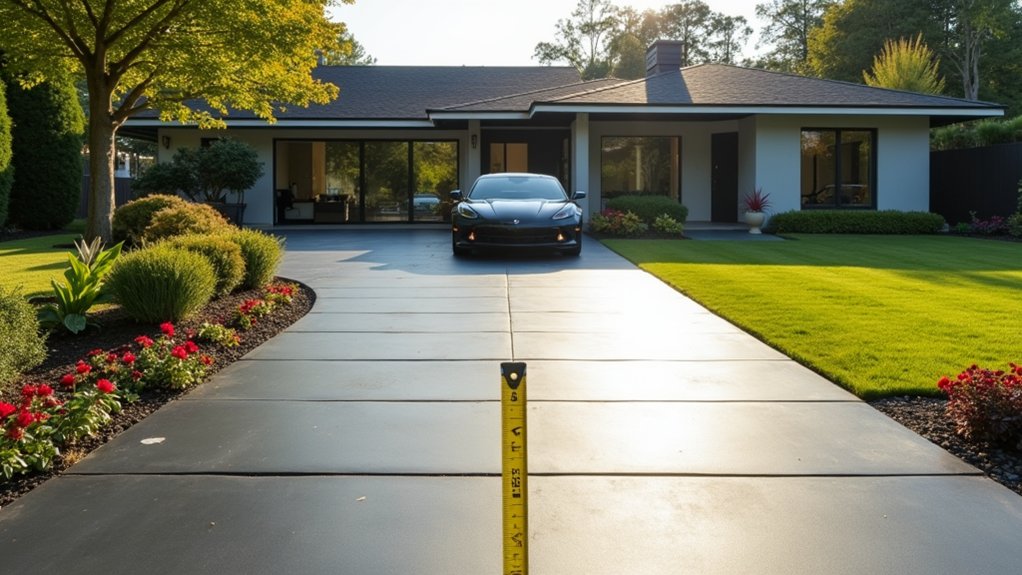Understanding UK driveway regulations is crucial for ensuring compliance and practicality. First, determine if you need planning permission, particularly for larger projects, or if your plans qualify under permitted development rights. It’s also important to follow local authority guidelines concerning materials and drainage. If you’re converting a front garden into a driveway, ensure you adhere to specific criteria to prevent issues down the line. Wondering how these regulations affect costs and environmental impact? There’s plenty more to uncover on this subject.
Table of Contents
ToggleKey Takeaways
- You often need planning permission for driveways that affect visibility, access, or cover more than five square metres without using permeable materials.
- If your property is in a conservation area or is a listed building, you’ll usually need specific approvals for any driveway work.
- Driveways must meet local council regulations, especially regarding drainage and the choice of materials to ensure proper water management.
- Following building regulations is crucial for safety, ensuring that emergency vehicles can access your property and that drainage is sufficient to prevent flooding.
- Using sustainable and permeable materials is recommended as they help reduce flooding risks, improve drainage, and can even boost your property’s value.
Understanding Driveway Planning Permission

If you’re thinking about adding or changing your driveway, it’s essential to understand the planning permission rules.
You’ll need permission if your changes affect visibility, alter access points to public roads, or involve large areas of non-permeable surfacing. For instance, if you plan to use tarmac or concrete, you may need consent due to potential flood risks. Additionally, local authority regulations can differ, so it’s wise to check with your local council to understand the specific requirements in your area. Engaging with local planning officers early can provide clarity on what is needed for your project.
Be ready to fill out application forms, submit scaled drawings, and pay a fee. Consulting with professionals can help make the process smoother and ensure you meet local laws.
Following these guidelines is crucial for both safety and sustainability in your driveway project.
Permitted Development Rights and Exceptions

Understanding Permitted Development Rights (PDR) and their exceptions is crucial for homeowners looking to alter their driveways.
Typically, PDR allows you to install driveways without needing full planning permission, as long as certain criteria are met. However, there are exceptions, particularly for flats, maisonettes, and properties converted from commercial use, which do require full planning permission.
If your property is in a conservation area or has specific planning conditions, PDR may not apply. Additionally, any driveway covering over 5 square metres must use permeable materials to avoid needing permission. Driveways must be at or near ground level to avoid planning issues.
For listed buildings, both planning permission and listed building consent are necessary. Always consult your local planning authority to clarify any restrictions that may affect your project.
Application Process for New Driveways
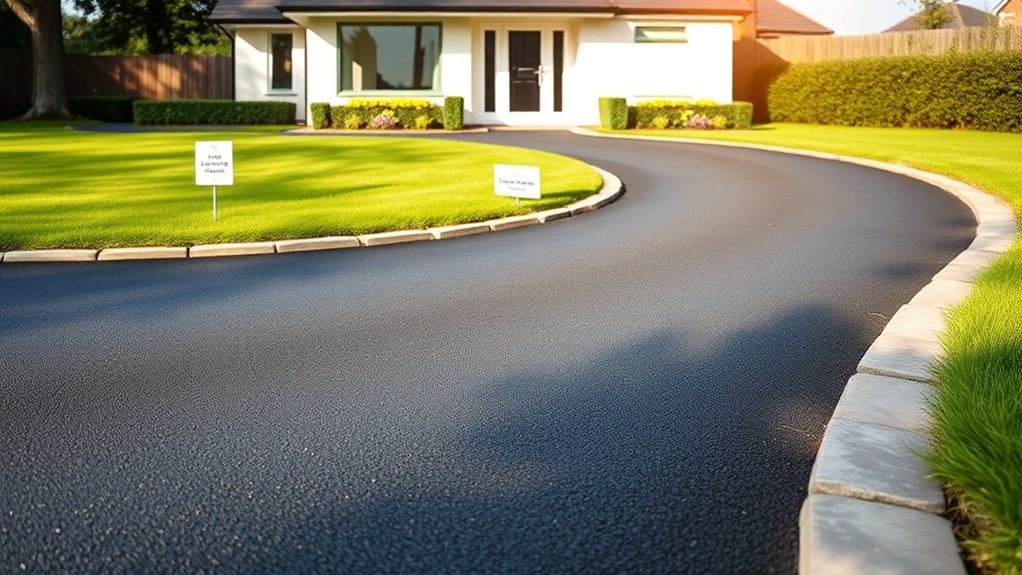
When applying for a new driveway, it’s important to find out if you need planning permission. Getting in touch with your local council early on can help you navigate the process smoothly and steer clear of common issues. Make sure to follow the correct steps for your application to ensure your driveway complies with all regulations. For instance, if your driveway will cover more than five square metres, you may need to use permeable materials or seek approval. Additionally, ensure that you comply with dropped kerb regulations to facilitate easy access for vehicles. Keep it straightforward to avoid unnecessary delays.
Planning Permission Requirements
Planning permission for new driveways can seem daunting, but it’s crucial to understand the requirements to ensure you comply with local regulations. Generally, you’ll need permission if you’re creating a new access point or significantly changing the dimensions of your existing driveway.
Start by checking with your local planning authority to see if your project is classified as permitted development or if a formal application is necessary. You’ll typically need to fill out an application form and provide supporting documents, including plans and specifications of your proposed driveway.
Make sure your design meets local building regulations and policies. For instance, if you’re installing a driveway that will alter drainage patterns, you may need to consider permeable materials to manage water runoff effectively.
Local Authority Consultation
Navigating the local authority consultation process is crucial for a successful driveway application. Engaging with local councils can provide valuable insights into guidelines, zoning restrictions, and potential compliance issues. By prioritising early engagement with the local authority, you can reduce risks and increase the likelihood of your project being approved.
| Aspect | Description | Benefits |
|---|---|---|
| Council Guidelines | Specific rules for driveway construction. | Ensures compliance. |
| Design Review | Early assessment of your driveway plans. | Spotlights any potential issues. |
| Material Selection | Choosing suitable materials. | Meets local standards. |
| Conservation Areas | Special considerations for listed properties. | Avoids regulatory delays. |
Understanding these elements will help streamline your application and maximise the benefits of consultation.
Application Submission Steps
Before starting the application process for a new driveway, it’s important to understand the steps involved for a seamless submission.
Firstly, check if you require planning permission and choose a qualified contractor. Gather all necessary measurements and design details, ensuring your driveway complies with standard dimensions.
Complete the application form with accurate details and include supporting documents, such as proof of insurance. Pay the application fee and follow the submission guidelines from your local council.
After submission, your application will be evaluated by the council, and be ready for a public notice period. If necessary, familiarise yourself with the appeals process in case of any rejections.
Following these steps can help ensure a smooth application experience.
Front Garden Conversions: What You Need to Know

When thinking about converting your front garden, it’s essential to be aware of the planning permission requirements that might be necessary.
Pay attention to the materials and design you select, as these must adhere to drainage regulations and local guidelines. Meeting these standards not only helps you steer clear of legal complications but can also boost your property’s value and improve its curb appeal.
For instance, using permeable paving can help with water drainage while maintaining a stylish look. Additionally, incorporating environmental benefits of permeable driveways can further enhance your property’s appeal and sustainability.
Planning Permission Requirements
Converting your front garden into a driveway can improve both accessibility and the look of your home.
However, it’s crucial to understand the planning permission requirements. Here are some key points to consider:
- Planning Exemptions: Driveways that cover less than five square metres typically don’t need planning permission.
- Permitted Development Rights: Many driveway projects are covered by these rights, meaning you can go ahead without needing explicit permission.
- Application Timelines: If you do need planning permission, be aware that applications can take several weeks, so it’s best to plan ahead.
If your property has restrictions, such as being a listed building, you may need additional consent.
Assuming your project falls under permitted development without confirming could lead to costly retrospective applications.
It’s always a good idea to check with your local council before starting any work.
Material and Design Considerations
Understanding the material and design considerations for transforming your front garden into a driveway is essential for ensuring it’s both practical and visually appealing.
When choosing materials, consider permeable options like gravel or permeable concrete blocks. These not only improve the look of your driveway but also help manage water runoff, reducing the risk of flooding. In contrast, impermeable materials such as asphalt may need extra drainage solutions.
Design elements like slope and gradient play a crucial role in directing water runoff, while local building regulations ensure safety and accessibility. Permeable driveways can also contribute to groundwater recharge, supporting healthy ecosystems and maintaining natural water cycles.
Strive for a layout that comfortably accommodates both vehicles and pedestrians. By prioritising durable, sustainable materials and thoughtful design, you can create a driveway that meets regulations and enhances your property’s charm.
Local Variations in Planning Regulations
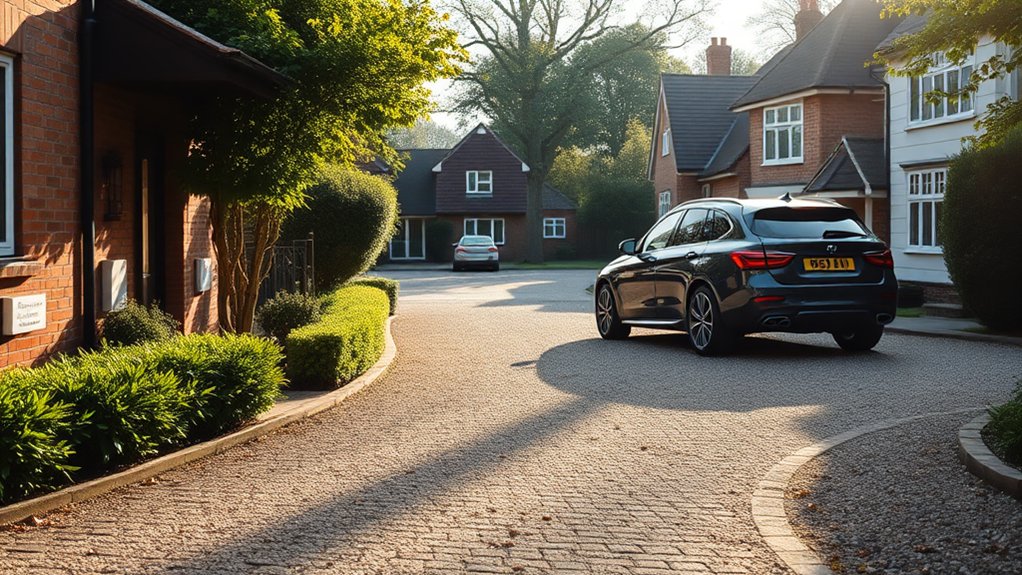
Local planning regulations for driveways can vary significantly across different areas in the UK, influenced by local geography and policy.
It’s crucial to understand these differences before starting your driveway project.
Here are some key considerations:
- Geographical constraints: Certain areas may require specific materials or design features due to local conditions.
- Permitted development rights: These can differ widely, with some councils implementing Article 4 Directions that limit what you can do without planning permission.
- Designated areas: Locations such as conservation zones often have stricter rules to preserve their character.
These local regulations can affect both the design and approval of your driveway.
Always check your local council’s planning website for the most current regulations and consider seeking pre-application advice to help navigate the process smoothly.
Building Regulations for Driveways

Building regulations for driveways are essential for ensuring safety, structural integrity, and proper drainage.
While many projects like resurfacing or landscaping may not require formal approval, it’s crucial to check with your local council. If you’re making structural changes or affecting drainage, you’ll need to comply with regulations.
For example, if you’re changing ground levels or installing underground drainage, these rules will apply. Using permeable materials can help manage surface water, while non-permeable surfaces over 5m² must channel water to permeable areas.
Always ensure your driveway design allows access for emergency vehicles and adheres to local regulations to avoid any complications.
Safety Considerations in Driveway Design
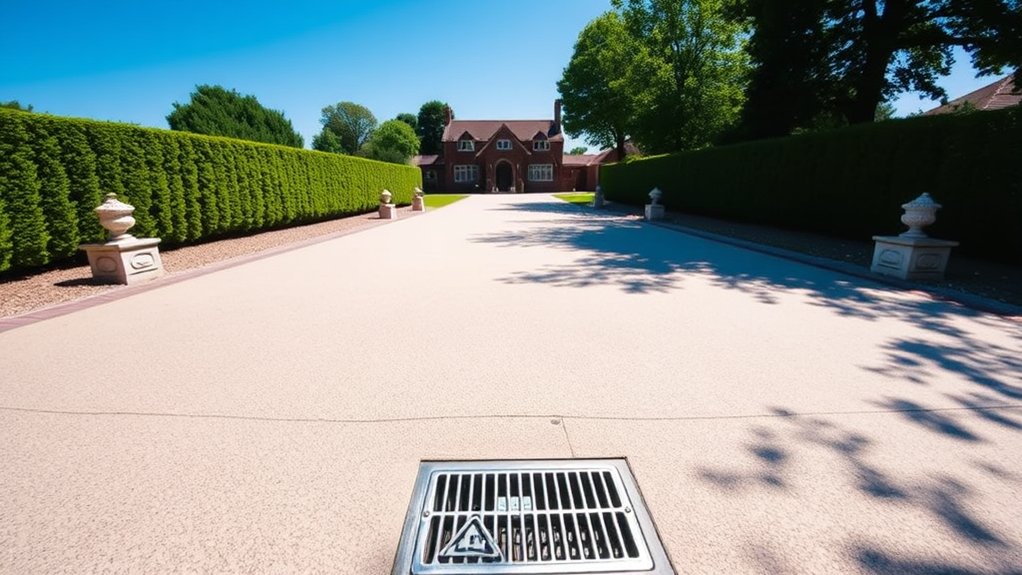
When designing your driveway, it’s crucial to prioritise effective drainage systems to prevent water pooling, which can create hazards.
Also, think about emergency access; ensuring that emergency vehicles can easily navigate your driveway without obstruction is essential for safety.
These considerations are vital not only for compliance but also for the safety of all users.
Proper Drainage Systems
Effective driveway drainage systems are crucial for safety and functionality, as they help prevent water accumulation that can cause flooding and damage.
To ensure your driveway meets regulations, consider these essential drainage solutions:
- Use permeable materials such as gravel or porous asphalt to manage surface runoff naturally.
- Create a sloped design that directs water away from public areas, minimising slip hazards.
- Install soakaways or French drains to effectively redirect excess water underground.
These methods will help keep your driveway safe and functional.
Emergency Access Planning
Emergency access planning is crucial when designing a driveway, as it affects the safety and response times of emergency services.
Ensure your driveway is at least 3.5 metres wide, or 3.7 metres for full fire crew access, to allow emergency vehicles to enter easily. A minimum height clearance of 4.0 metres is necessary for fire engines.
If your driveway exceeds 150 feet, include a turnaround area to prevent emergency vehicles from having to reverse, which enhances fire safety compliance.
Check with local authorities to ensure that any security gates permit quick entry for emergency responders, and regularly test these mechanisms to maintain reliable access.
Material Choices for Driveway Construction

Selecting the right materials for your driveway is crucial for both appearance and functionality.
Consider factors such as compliance with local regulations and the unique properties of each material. Here are some common options:
- Asphalt: An economical choice that can be complemented with permeable paving for improved drainage.
- Block Paving: Available in various colours and patterns, it adds visual interest to your driveway.
- Concrete: Known for its durability, it can be customised with different textures to enhance its look.
Choose materials that ensure stability for vehicles, reduce slipping hazards for pedestrians, and offer long-lasting performance.
Always ensure your selection aligns with local regulations and contributes to the safety of your property.
Environmental Impact of Driveways

When choosing driveway options, it’s important to consider their impact on the environment, especially in terms of surface permeability and biodiversity. Non-permeable driveways can lead to increased surface water runoff, which raises the risk of flooding in urban areas as drainage systems become overwhelmed.
By selecting sustainable materials like permeable paving or gravel, you can improve drainage and lessen flood risks.
Additionally, replacing gardens with driveways can displace local wildlife, reducing habitats that are crucial for birds, insects, and small mammals. This loss contributes to urban habitat fragmentation, which harms local ecosystems.
To support wildlife, consider incorporating green spaces or wildflower meadows into your driveway design. Your choice of driveway materials can significantly affect both environmental health and the well-being of local wildlife.
Maintenance and Repair of Driveways
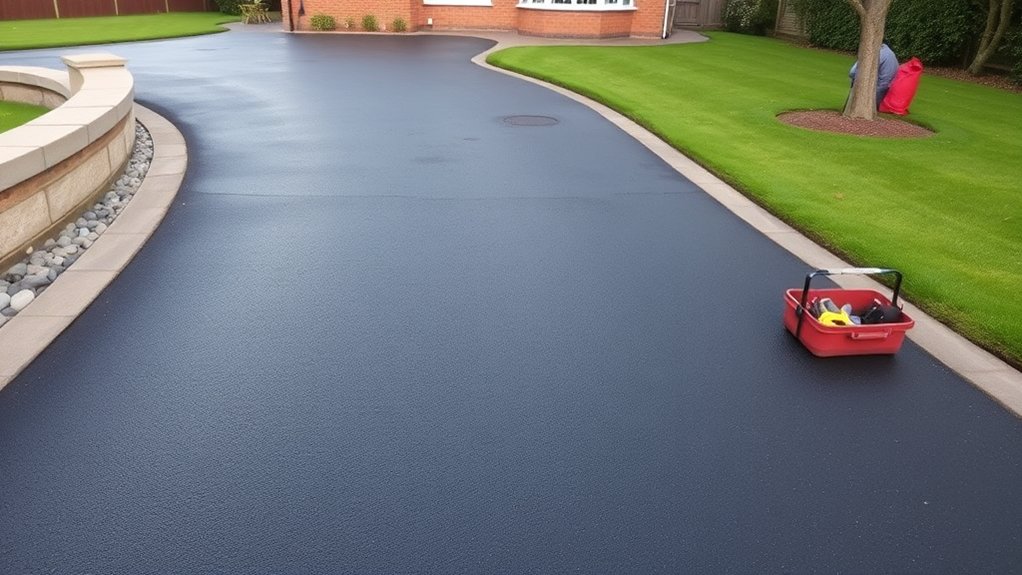
While driveways might appear to require little upkeep, regular maintenance is essential to avoid expensive repairs and ensure they last.
To keep your driveway in prime condition, follow these key maintenance tips:
- Seal your driveway: Apply the initial seal 60–90 days after installation, then reseal every 2–4 years using environmentally friendly products.
- Check for cracks: Regularly inspect for cracks and fix them promptly to prevent further damage and maintain the driveway’s strength.
- Clean regularly: Sweep away debris and gently wash the surface to minimise moisture build-up, which helps prevent cracking.
Enhancing Driveway Safety and Security

Driveway maintenance is crucial for ensuring safety and security. Clear signage, such as speed limit signs and pedestrian crossings, helps alert drivers and reduce risks.
Adding security features like gates or fencing can deter unauthorised access. Proper lighting is vital for illuminating the area at night, making it safer for both pedestrians and vehicles.
Regular inspections are necessary to remove obstructions and debris, keeping the path clear. It’s also important to follow local regulations regarding layout and accessibility to ensure a functional design.
Economic and Environmental Implications of Driveway Projects
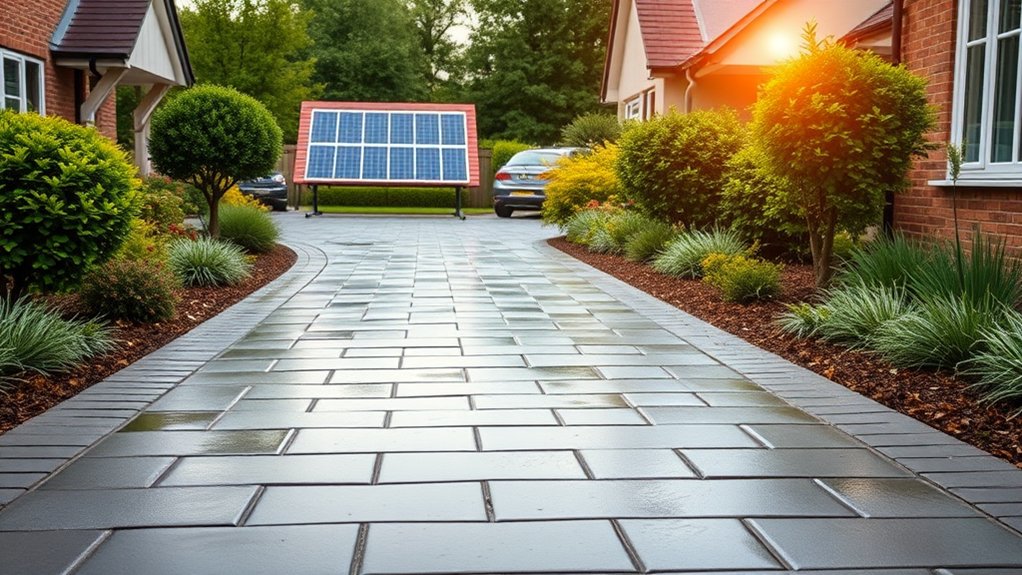
When considering a driveway project, it’s essential to think about both the economic and environmental aspects. Here are some key points to consider:
– Initial Costs vs. Long-Term Savings: Although sustainable materials might seem pricier at first, they typically result in lower maintenance and energy costs over time.
For instance, a permeable driveway may cost more upfront but reduces the need for drainage solutions later.
– Property Value Enhancement: Eco-friendly driveways can significantly increase your property’s value, making it more attractive to prospective buyers.
A well-designed driveway using recycled materials can set your home apart in the market.
– Environmental Impact: Traditional driveway materials can deplete natural resources and contribute to pollution.
In contrast, options like permeable paving help reduce surface runoff and promote groundwater replenishment, benefiting the local ecosystem.
Frequently Asked Questions
Can I Install a Driveway Without a Professional Contractor?
Yes, you can install a DIY driveway, but it’s essential to check local regulations, permits, and inspections first. For instance, different councils in the UK have specific rules regarding materials and drainage. Make sure you fully understand these requirements to avoid costly mistakes as a homeowner taking on this project.
What Is the Average Cost of Driveway Installation in the UK?
Imagine your ideal driveway. In the UK, the average cost for installation usually falls between £60 and £120 per square metre. This price can vary based on the materials chosen and factors like size and complexity of the job. For instance, a simple block paving driveway may be on the lower end of that scale, while a more intricate design with decorative stones could push the price higher.
How Long Does It Take to Build a Driveway?
A driveway construction timeline usually takes between 3 to 10 weeks. This can vary based on factors such as site preparation, obtaining permits, and the curing process. Weather conditions can also cause delays, so it’s wise to account for that in your planning.
Are There Specific Materials Prohibited for Driveways?
Permeable materials for driveways work like a river, allowing water to flow through. In the UK, solid surfaces that don’t let water permeate are often not allowed. Choosing the right materials ensures you meet regulations and helps protect the environment by reducing flood risks. For example, gravel or permeable paving are good options that allow rainwater to soak in.
What Are the Common Driveway Design Trends in the UK?
Common driveway design trends in the UK feature gravel driveways for their breathability and permeable paving to minimise runoff. Many homeowners are opting for minimalist styles and incorporating technology to boost both functionality and aesthetics in modern outdoor spaces.
Conclusion
Navigating UK driveway regulations can seem daunting, but understanding the key rules is essential for creating a functional and attractive front space. Knowing about planning permissions, local variations, and environmental considerations will ensure your driveway not only boosts your home’s appeal but also meets community standards. For example, if you’re considering a gravel driveway, be aware that you may need to install a permeable surface to manage drainage effectively. By staying informed, you can create a driveway that complements your home and fits seamlessly into your neighbourhood.
Know the essential steps to secure planning permission for your tarmac driveway—discover key insights that could save you time and Read more
Learn about driveway width regulations and discover the essential requirements that could affect your property—find out how wide your driveway Read more
Can you install a driveway without planning permission? Consider size, materials, and regulations—discover what you need to know before starting Read more



